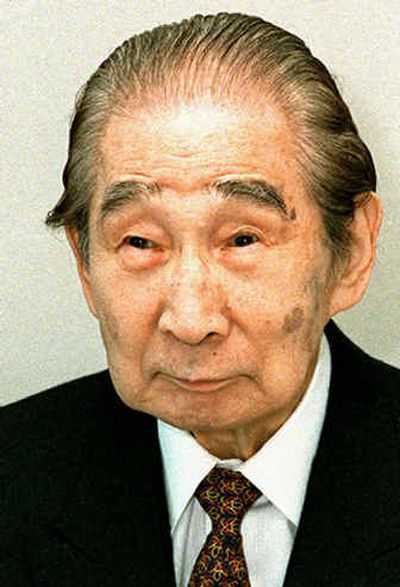In passing

Kenzo Tange, 91, prize-winning architect
Tokyo Kenzo Tange, a prize-winning architect celebrated for the beauty of his structures, including stadiums for the 1964 Tokyo Olympics, died Tuesday. He was 91.
Tange, who worked until he was 88, died of heart failure. He had been resting at his Tokyo home, said Kazuo Aso, a spokesman for his design office, Tange Associates.
Tange saw in the ashes of World War II a chance to create not just new buildings, but new cities. His Peace Center in Hiroshima, built four years after the U.S. atomic bombing in 1945, was designed to become the “spiritual core” of the city.
In the work considered his masterpiece – the twin gymnasiums designed for the 1964 Tokyo Olympics – he placed two comma-shaped buildings with sweeping roofs like upside-down ships’ hulls so as to connect two busy Tokyo districts.
The jury that awarded Tange the prestigious Pritzker Prize for architecture in 1987 called him a leading theoretician of architecture and an inspiring teacher.
“His stadiums for the Olympic Games held in Tokyo in 1964 are often described as among the most beautiful structures built in the 20th century,” the jury said.
Later in his career, Tange designed buildings in China, Singapore, Australia, Malaysia, Nepal, Saudi Arabia, Iran, Kuwait, Nigeria, Italy, Yugoslavia and the United States.
Born in Osaka on Sept. 4, 1913, Tange’s visions were often ambitious, including a plan to redesign the chaotic, haphazard streets of Tokyo.
As a professor at Tokyo University’s Architecture School, Tange also taught Kisho Kurokawa, who designed Amsterdam’s famed Van Gogh Museum and the Kuala Lumpur airport. Fumihiko Maki, the architect of the Spiral Building in Tokyo’s chic Omotesando district and the 1993 winner of the Pritzker Prize, was another of his students.
Barney Martin, 82, Seinfeld’s TV dad
Los Angeles Barney Martin, a film, television and stage actor who became known to millions of TV viewers in the 1990s as Jerry Seinfeld’s dad on “Seinfeld,” has died. He was 82.
Martin died Monday of cancer at his home in Los Angeles.
Martin was a New York City police detective who would use humor to spice up speeches for deputy commissioners when he started in show business by writing on the side in the 1950s for “Name That Tune” and “The Steve Allen Show.” He began acting in the 1960s, and Mel Brooks cast him in the “The Producers” in 1968. In 1981, he played Liza Minelli’s father in “Arthur.”
Martin also appeared several times on Broadway, including the role of murderer Roxie Hart’s nebbishy husband, Amos, in the original production of the Bob Fosse musical, “Chicago,” in 1975. Martin introduced the song “Mr. Cellophane.”
Although Martin was the third actor to play Seinfeld’s father, he is the one most identified with the role of the Florida retiree, Morty. He once said that Morty’s job as a dad was to save his son money.
“Morty’s whole drive is to take care of his family,” Martin said.
Among the more notable episodes involving his character was one in which Morty and his wife were the stars of their Florida condo association’s annual show. There was also the episode where Morty invents the “Executive,” a beltless trench coat that Kramer wanted to sell.
Martin wore the raincoat to the show’s wrap party in 1998 and had the cast sign it.
He said at the time: “Playing Jerry’s dad was like having whipped cream on top of a mountain of ice cream.”
Paul Henning, creator of ‘Beverly Hillbillies’
Burbank, Calif. Paul Henning, who created the hit TV show “The Beverly Hillbillies” and wrote its theme song, died Friday of natural causes, his daughter said. He was 93.
Henning, who lived in Toluca Lake, Calif., died in a Burbank hospital.
Henning created “The Beverly Hillbillies,” which debuted in 1962, based on his encounters with residents of the Ozarks during camping trips as a youth.
The CBS series starring Buddy Ebsen as the patriarch Jed drew up to 60 million viewers at its peak and ran until 1971.
Henning also wrote the words and music to “The Ballad of Jed Clampett,” which was sung by Jerry Scoggins while Nashville bluegrass stars Lester Flatt and Earl Scruggs played guitar and banjo.
In 1963, Henning created “Petticoat Junction,” a “Hillbillies” spinoff.
Later in his life, Henning and his wife Ruth donated land near Branson, Mo., to the state for a conservation area.